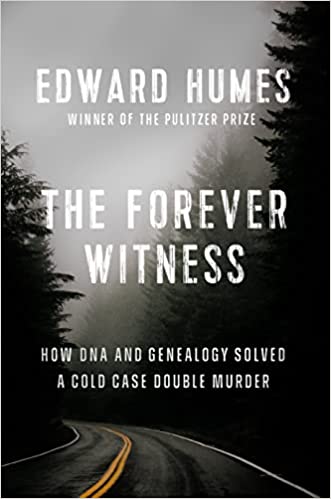
From the publisher: A relentless detective and an amateur genealogist solve a haunting cold case — and launch a crime-fighting revolution that tests the fragile line between justice and privacy. Genetic genealogy, long the province of family tree hobbyists and adoptees seeking their birth families, has made headlines as a cold case solution machine, capable of exposing the darkest secrets of seemingly upstanding citizens. But as this crime-fighting technique spreads, its sheer power has sparked a national debate: Can we use DNA to catch the murderers among us, yet still protect our last shred of privacy in the digital age—the right to the very blueprint of who we are?
I’ve been reading a lot of true crime, and The Forever Witness is a great example written by an experienced and talented writer. Edward Humes is a Pulitzer-Prize winning journalist who pays extreme attention to detail and can really turn a phrase. This book weaves together multiple cold case murders with fascinating information on how far genetic genealogy has come. It challenges us to think about the ramifications of using genetic genealogy to uncover criminals using the DNA of innocent relatives.
The story focuses on the murders of two young Canadians, Tanya Van Cuylenborg and Jay Cook, who travelled to the US in November 1987 to pick up a furnace for his father’s service and repair business. Their bodies were found in two separate remote locations a few days after they disappeared, and they had been killed in very different ways. Thirty years later, the crime still had not been solved; then came new developments in genetic genealogy.
The author does a great job helping us get to know the young couple by presenting little details about their lives. He sympathetically presents the anguish of their friends and relatives. As fascinated as he is by the science used to uncover the truth, he is sensitive to the fact that he is writing about real people.
The segue into discussion about genetic genealogy was technical but also fascinating. I learned a lot. In 2016, a company called Parabon NanoLabs introduced cutting-edge DNA technology called Snapshot that can generate a composite sketch of a suspect from DNA trace evidence. A couple of examples are included in the book, of Snapshots and the actual killers, and the similarities are striking.
In the end, a true crime novel that reveals a killer is both sad for the victims and satisfying when justice is done.
I read an advance reader copy of The Forever Witness from Netgalley.
The Forever Witness adds a riveting layer of science to the true crime template. If you enjoy true crime works that also cover science and discuss pressing social issues, you may enjoy The Forever Witness. The Galesburg Public Library will own it once it is released in late November.

